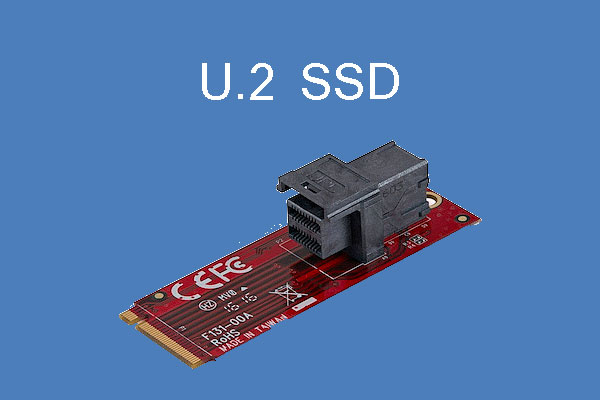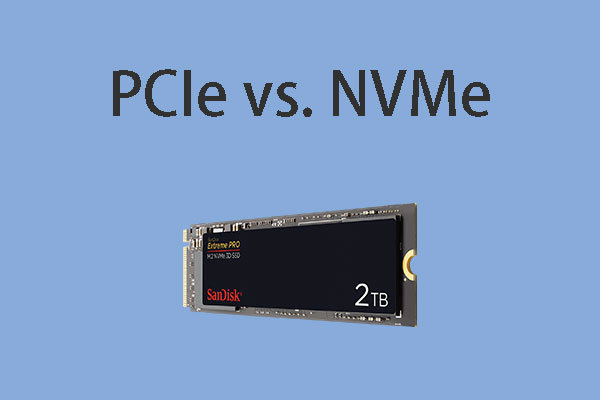U.3 has come out and it is replacing U.2. Do you want to know the difference between U.2 and U.3? This post from Partition Magic explains SSD U.2 vs U.3 to you. Read it to know the difference.
What Is U.2 SSD?
A U.2 SSD is namely an SSD with an U.2 physical port, which is a hardware interface for connecting drives, particularly nonvolatile memory express (NVMe) SSDs, to a computing device over the PCIe bus.
A typical U.2 port is usually composed 2x SATA 6Gbps lanes and 4x PCI-E 3.0 lanes. Therefore, the U.2 port is usually compatible with SATA, SATA-E, and SAS interfaces. That is, if your motherboard has a U.2 port, you can usually connect a SATA, SATA-E, or SAS hard drive to this U.2 port.
However, a U.2 SSD usually uses the NVMe standard protocol and PCI-E 3.0×4 bus, which makes the U.2 SSD have a theoretical bandwidth up to 32Gbps and have advantages of high speed, low latency, and low power consumption. A U.2 SSD cannot be inserted into SATA or other ports.
The U.2 SSDs usually have two models. One is the traditional PCI-E expansion card model, and the other is the 2.5-inch U.2 interface disk style. You can pick one according to your needs.
What Is U.3 SSD?
A U.3 SSD is namely an SSD with an U.3 physical port. As the name suggests, U.3 is built on the U.2 specification. It uses the same SFF-8639 connector as U.2 and combines support for SATA, SAS and NVMe in a single controller.
Through the optional Tri-Mode Controller, the U.3 port supports the interchangeable use of NVMe SSDs, SAS hard drives, and SATA hard drives in the same slot, which simplifies the deployment and upgrade of hard drives.
In addition, since U.3 and U.2 use the same SFF-8639 physical connector, there is no essential difference in the interface and appearance of the corresponding NVMe SSDs.
However, in terms of compatibility, U.3-based NVMe SSDs must support backward compatibility with U.2 hosts. It means that customers can directly use U.3 NVMe SSDs on servers that support U.2 NVMe SSDs, but U.3 hosts cannot support U.2 hard drives.
SSD U.2 vs U.3
After reading the above contents, you can know the difference between U.2 and U.3 ports. Apparently, U.3 is better than U.2. The advantages of U.3 specification are as follows:
- Provides greater flexibility and configurability while reducing system complexity and cost by consolidating SAS, SATA, and NVMe drives and simplifying systems with cost-effective cables and components.
- Enables SAS, SATA, and NVMe protocols through a single drive slot.
- Supports standard management tools across server storage protocols.
- Combines the benefits of SAS, SATA, and NVMe drives for better performance.
- Provides an option to support NVMe, which is more attractive than SAS and SATA.
- Maintains backward compatibility with U.2.
As for SSD U.2 vs U.3, some people may want to know the performance difference between them. In this case, hard drive benchmark software is recommended. Taking MiniTool Partition Wizard as an example, it can test the real read and write speeds of a hard drive on a specific device.
MiniTool Partition Wizard FreeClick to Download100%Clean & Safe
In addition, the Disk Benchmark feature of MiniTool Partition Wizard is free. If you want to know the speed difference of U.2 and U.3 SSDs on your device, you can use MiniTool Partition Wizard to test their speeds on your device. Just have a try.
Bottom Line
Do you want to know SSD U.2 vs U.3? This post introduces this topic to you in detail. After reading this post, you can know how to choose between them.



![How to Measure Disk Performance Easily [Step-By-Step Guide]](https://images.minitool.com/partitionwizard.com/images/uploads/2019/06/disk-performance-test-thumbnail.jpg)
User Comments :